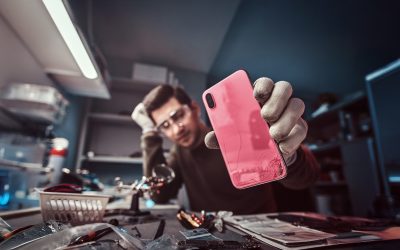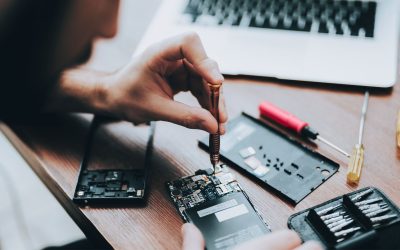With counterfeit iPhones flooding both online marketplaces and offline stores, the risk of accidentally purchasing a fake device is higher than ever. These impostors can appear deceptively similar to the originals, but may disappoint you with unreliable performance, security vulnerabilities, and no warranty support.
At Cell Medics, we’re dedicated to helping you make smart, informed decisions. In this guide, we’ll walk you through how to distinguish a genuine iPhone from a fake one confidently and why it’s so important to buy certified devices from authorized sellers.
Why It Matters
Counterfeit iPhones might save you money upfront, but the hidden costs are steep:
- Poor performance: Fake devices often run slowly, with subpar processors and displays.
- Security risks: They may include malware or unpatched software, making your data vulnerable.
- No warranty or support: You won’t get help from Apple or its authorized service providers.
- Low quality and potential data loss: These phones may not have reliable parts, which could break, resulting in data loss.
In short: buying smart now saves you time, money, and hassle later.
Key Signs to Check
1. Packaging & Accessories
Apple packaging is intentional and premium. Red flags include:
- Box quality: The box should be rigid with crisp, well‑aligned printing. Counterfeits often use flimsy boxes with sloppy text.
- Seals: Starting with the iPhone 13, Apple has removed plastic wrap from iPhone packaging. Ensure the box is sealed with two pull tabs at the top and bottom of the back of the box.
- Accessories: Look for “Designed by Apple in California” on the cable and charger. Fake accessories often feel cheap or have spelling errors.
2. Serial Number & IMEI Verification
One of the most reliable checks:
- Find the numbers: Go to Settings → General → About to find your serial number and IMEI. You can also dial *#06# to retrieve your IMEI.
- Match labels: Verify that the numbers on the phone, SIM tray, and box are identical.
- Verify online: Enter the number on Apple’s Check Coverage website. Real devices will display the correct model information and warranty status. Ensure the purchase date aligns with when the device was purchased and that the model matches your device. Fake device manufacturers have become more sophisticated and have copied the serial numbers of existing models, so use this as one of many checks.
If there’s any mismatch or the number isn’t recognized, it’s likely a fake.

Screenshot from Custom Adventurist on YouTube.
3. Physical Build Quality
Apple’s craftsmanship is hard to duplicate:
- Materials: Real iPhones feel sturdy, with tight tolerances and fluid button action. Fakes often have rough edges or loose buttons.
- Screen & weight: The Retina display should be sharp and responsive. Compare the weight and dimensions to Apple’s official specs.
- Logo and ports: The Apple logo is laser‑precise; ports line up flush with clean edges—something cheap fakes overlook.
Use a magnifying glass to detect misaligned logos or uneven textures and use Apple’s device comparison tool to see features by model.
4. Software & Features
Fake iPhones often mimic iOS, but under the hood, they run Android or custom UIs
- True iOS: iPhones only run iOS. If you see an app store other than Apple’s, it’s fake.
- Test Siri: Hold the side button or say “Hey Siri.” If Siri doesn’t activate, something’s off.
- Settings check: Genuine iOS shows the correct version in Settings → General → Software Update.
- Connect to iTunes/Find My: A genuine iPhone should be recognized by Find My on Mac or iTunes on Windows—fake ones may not be.
5. UI & Font Details
Even small font details can reveal fakes:
- System fonts: iOS uses Apple’s proprietary San Francisco font. Fakes may use generic Android fonts.
- Lock‑screen elements: Genuine iPhones have shortcut icons for Camera and Flashlight; fakes sometimes display weird icons instead.
- Navigation bars & spacing: iOS design is precise; fakes may have extra margins, misalignment, or incorrect text spacing.

Screenshot from Custom Adventurist on YouTube.
6. Camera & Speaker Layout
Small design inconsistencies can give them away:
- Camera glass: Real iPhones have precisely manufactured camera rings; fakes often have thicker plastic outlines and more transparent camera glass.
- Speaker grills: Apple speaker holes are uniform and clean; counterfeit ones are often uneven or smaller.
Compare any suspect device to online photos of the exact iPhone model for visual differences.
7. Price & Source
If it’s too good to be true, it probably is:
- Check price history: A significant discount off Apple’s MSRP is a red flag.
- Where you buy: Shop with trusted sources—Apple stores, authorized resellers, or reputable carriers. Avoid random online listings or unauthorized shops.
- Ask for documentation: Proof of purchase or AppleCare+ records help validate authenticity. Watch for fake receipts with spelling errors or inconsistent details.
8. Authorized Service Check
When in doubt:
- Call Apple Support: They can verify device authenticity using remote diagnostics or serial number checks.
- Visit a Genius Bar: Apple technicians can quickly test hardware and software for authenticity.
Step‑by‑Step Checking Guide
- Unpack & inspect the box and accessories for premium quality.
- Match serial & IMEI on the device, box, and SIM tray.
- Enter these numbers on Apple’s Check Coverage site.
- Power on the iPhone and test Siri, Camera, and App Store.
- Connect to iTunes/Find My and confirm device recognition.
- Examine UI fonts and button layouts for iOS consistency.
- Compare the button feel, ports, and camera layout against the official model specifications.
- Double‑check price versus MSRP, and verify seller credibility.
- Consult Apple Support or visit a Apple Authorized Service Provider if you have any remaining doubts.
Buying Tips & Trusted Sources
When purchasing an iPhone:
- Buy from official channels: Apple.com, Apple Stores, authorized resellers, or your telecom provider.
- Ask to test in Apple’s presence: At a Genius Bar or authorized retailer.
- Avoid “too cheap to be real” deals: Deep discounts often signal counterfeit products.
To avoid fake iPhones, don’t rely on one sign—combine multiple checks, and remember: if it seems too good to be true, it probably is.
By following our checklist, you’ll dramatically reduce the risk of buying a counterfeit iPhone. At Cell Medics, we’re here to help you stay confident in your tech investments—reach out if you need device diagnostics, accessories, or repair services you can trust.
Feel secure in every purchase. Got a question about a device or need help with broken screens, batteries, or data recovery? Contact us or explore more on our Blog for expert advice and tips.






